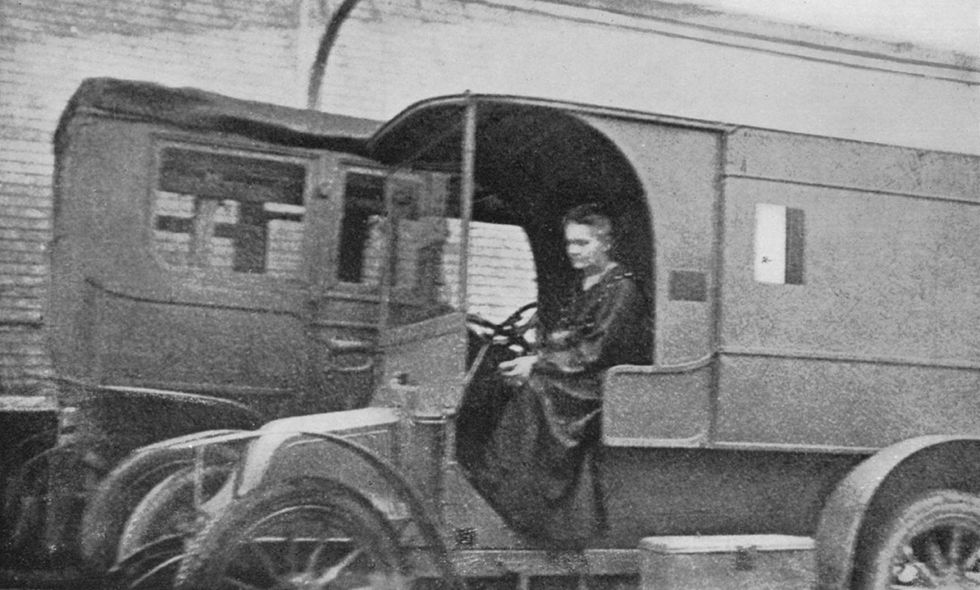THE INSTITUTEBy 1914 Marie Skłodowska Curie had already made several pioneering contributions to the field of radioactivity, including discovering the radioactive elements radium and polonium. When World War I broke out in Europe that year, Curie saw a way to apply her expertise to help save the lives of wounded soldiers.
She realized that the electromagnetic radiation of X-rays could help doctors see the bullets and shrapnel embedded in the soldiers’ bodies and remove them, as well as locate broken bones. Many hospitals in France already had X-ray equipment, but those machines were often far from the battlefield.
To move the technology closer to the soldiers, Curie and her daughter amassed a fleet of vehicles equipped with X-ray machines and set up 200 radiological units in more permanent posts during the first two years of the war.
A CALL TO ARMS
Curie, who was born in Poland, was living in Paris in 1914 when the war began. As founding director of France’s Red Cross Radiology Service, she was in the midst of setting up her laboratory at the Radium Institute, a new center in the city for the study of radioactivity. Construction was complete, but many of her researchers were off fighting the war. Just before the German army’s invasion, the French government moved the country’s capital to Bordeaux. Curie transported France’s only sample of radium in a safe-deposit box to the city, 600 kilometers southwest, but she quickly returned to Paris, determined to apply her scientific knowledge to aid the war effort.
Curie approached her wealthy friends and colleagues to donate automotive vehicles which when modified could be used as mobile X-ray units. And she persuaded French manufacturers of X-ray equipment to donate it along with portable electric generators. She also asked local body shops to voluntarily outfit the vehicles with the equipment so it could be positioned in field hospitals close to the front. By October 1914, the first of 20 vehicles, which French soldiers dubbed petites Curies (little Curies), were ready.

Although Curie had lectured about X-rays at Sorbonne University (now Paris Sorbonne University), she had no practical experience working with them. So she took crash courses on how to operate the equipment and on human anatomy so she could learn how to read the film. She also learned how to drive a car and how to fix it if necessary. Accompanied by a military doctor and her 17-year-old daughter, Irène, for an assistant, Curie made her trip to the battlefront in October 1914. In less than two years, the number of units had grown substantially, and the Curies had set up a training program at the Radium Institute to teach other women to operate the equipment.
Curie also opened her wallet to aid the war effort. She was the first woman to receive a Nobel Prize, in 1903, for physics, and she went on to receive the 1911 Nobel Prize in Chemistry. She offered to donate her gold medals to the French government to aid the war effort, but the French National Bank turned her down. Instead, she used most of her Nobel Prize money to buy French war bonds.
The war ended on 11 November 1918, and a year later her laboratory at the Radium Institute was finally ready. There, she would dedicate herself to research until she died in 1934 at age 66 of aplastic anemia—a rare condition in which the body stops producing enough red blood cells. Her anemia was attributed to the lack of protection from radiation exposure when she operated the mobile X-ray units, as well as the radon gas tubes she carried in her pockets during her research.
To learn more about Curie’s life and contributions, visit the Engineering and Technology History Wiki.
This article was written with assistance from the IEEE History Center, which is funded by donations to the IEEE Foundation.
![Photo of Marie Curie [right] and her teenage daughter, Irène.](https://spectrum.ieee.org/media-library/photo-of-marie-curie-right-and-her-teenage-daughter-irene.jpg?id=25587966&width=1200&height=900)


